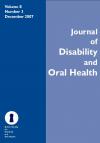Journal of Disability and Oral Health

- Cover Date:
- December 2007
- Print ISSN:
- 1470-8558
- Electronic ISSN:
- 1754-2758
- Vol:
- 8
- Issue:
- 3
Editorial
It is an honour and a pleasure to have the opportunity to write the Editorial for this issue of the Journal of Disability and Oral Health. Not being a clinician, but a disability equality consultant, the focus of this piece is very much around the social and environmental aspects of disabled people accessing dentistry and oral health services, and the role the profession has to play in promoting disability equality. Well over ten million people in the UK have a disability and one in five patients is likely to be covered by the Disability Discrimination Act (DDA). It is, however, interesting to note that recent research by the former Disability Rights Commission indicates that over 40% of disabled people covered by the DDA do not consider themselves as disabled. The reasons for the increase in the number of disabled people in the UK are numerous, and include advances in medical treatment, increasing survival rates and an older population. It is also the case that the ever evolving legal definition of disability has meant an increase in the number of disabled people covered. It should also be remembered that seven out of ten disabled people become disabled during their working lives. Treating disabled people is, in fact, becoming less of a speciality and more of a norm. The skills and knowledge needed may sometimes be different and require subject matter expertise but, as a competency, the ability (and confidence) to treat disabled people needs to become part and parcel of a dentist’s skills portfolio. barriers that disabled people can still encounter when trying to access oral health services. These are by no means always explicit or deliberate but can, sometimes, be borne out of low levels of disability awareness, which can result in a lack of confidence and, at worst, a lack of enthusiasm and/or willingness to treat disabled people. The social model of disability places less emphasis on the impairment and more on the environmental barriers that can prevent disabled people accessing good oral health ser vices. The impairment will always be important when deciding on a clinical treatment, but a patient centred approach is essential when ensuring that disabled service users have the same level of access, informed choice and customer service as anyone else. It seems fair to say that in a minority but real number of cases treatment plans are still decided on the basis of easing the burden on the practitioner rather than as a result of the infor med choice of the disabled person (or their advocate). Disability awareness training, based on the social model of disability must therefore be seen as an essential ingredient to achieving disability equality. Another key ingredient to disability equality is the active engagement of disabled people in the way non-clinical services for disabled people are devised and delivered. A patient centred approach again is something familiar to treatment planning; what is also needed is to develop the concept further when developing service delivery. Dentistry has already demonstrated its willingness to be receptive to the needs of disabled people and it is also likely that it will also be one of the sectors to lead the way in promoting disability equality in health provision. Nick Goss Disability Equality Consultant Member of the Editorial Board of the Journal of Disability and Oral Health
- Article Price
- £15.00
- Institution Article Price
- £15.00
- Page Start
- 98
- Page End
- 98
- Authors
- Nick Goss
Articles from this issue
- Title
- Pg. Start
- Pg. End
- A prospective audit of a Day Stay Hospital service for the dental management of adults with disabilities
- 99
- 104
- Intranasal and intravenous sedation with midazolam in a child with special needs – a case report
- 111
- 114
- The importance of follow-up dental findings to diagnose Sauk syndrome: a case report in a child
- 118
- 123
- Mastocytosis – oral and dental manifestations and medical considerations for dental treatment: a case report
- 124
- 128
- Evaluation of oral health knowledge among personnel in an institution for the rehabilitation of disabled young adults
- 135
- 141
